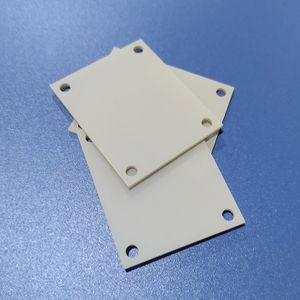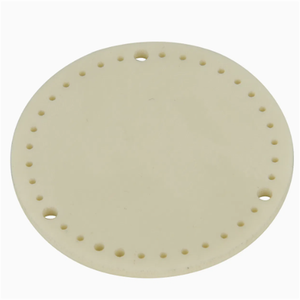Discover Premium Ceramic Products | Durability & Elegance United | Advanced Ceramics
PRODUCT PARAMETERS
Description
Overview of aluminum nitride ceramics
Aluminum Nitride Ceramic is an advanced ceramic material with aluminum nitride as the main component. It has been widely used in electronics, optics, and mechanics due to its unique properties.
Features of aluminum nitride ceramics
High thermal conductivity: Aluminum nitride ceramics have relatively high thermal conductivity, usually between 170-260 W/m·K, which makes it an excellent heat dissipation material. It is especially suitable for electronic devices that require efficient heat dissipation, such as substrate materials for power semiconductor devices.
Good electrical insulation: Despite its high thermal conductivity, aluminum nitride ceramics are excellent insulators of electricity, which can effectively prevent current leakage and ensure the safe operation of electronic components.
Low dielectric constant and dielectric loss: These characteristics make aluminum nitride ceramics very suitable for use in high-frequency circuits because it can reduce energy loss during signal transmission.
High temperature resistance: Aluminum nitride ceramics can maintain structural stability and strength at extremely high temperatures. Its melting point is about 2800°C, so it is suitable for applications in high temperature environments.
Low thermal expansion coefficient: Compared with semiconductor materials such as silicon, aluminum nitride has a lower thermal expansion coefficient, which means it has better dimensional stability when the temperature changes, which helps improve packaging reliability.
Corrosion resistance: Aluminum nitride ceramics have good chemical stability to most molten metals and are not easily oxidized or corroded, allowing them to perform well in harsh environments.
High mechanical strength: Although not as hard as some other types of ceramic materials, aluminum nitride ceramics still provide enough mechanical strength to allow them to be used in many structural applications.
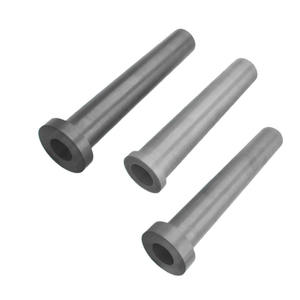
(AlN/aluminum Nitride Ceramic Crucible)
Specifications of AlN/aluminum Nitride Ceramic Crucible
The AlN Porcelain Crucible is created for high-temperature applications. It works well in laboratories and commercial setups. The material is light weight aluminum nitride. This offers strong thermal conductivity and chemical stability. The crucible handles severe warmth and withstands thermal shock.
Light weight aluminum nitride has high thermal conductivity. This residential property aids warmth spread uniformly. It stops locations from forming. The thermal conductivity ranges between 170-200 W/m · K. This is much better than alumina ceramics. The crucible can handle quick temperature adjustments. It remains secure from space temperature level approximately 1400 ° C
. The crucible stands up to chemical corrosion. It does not react with molten steels. It collaborates with salts, acids, and bases. This makes it valuable in severe atmospheres. It stays inert in temperatures approximately 980 ° C in oxidizing problems. It goes higher in non-oxidizing settings.
Mechanical strength is an essential attribute. The material has high solidity. Vickers firmness is 1200-1400 HV. Compressive strength surpasses 2000 MPa. This protects against fractures under heavy tons. It lasts longer under anxiety compared to other porcelains.
The crucible has low porosity. Thickness is around 3.26 g/cm SIX. Open up porosity is below 0.5%. This stops contaminants from entering. It maintains samples pure throughout experiments. The purity level mores than 99%. This minimizes undesirable reactions.
Typical usages include semiconductor processing. It melts steels like gold and silicon. It grows crystals in regulated settings. It works in vacuum or inert gas settings. It fits jobs requiring accurate temperature control.
Dealing with the crucible calls for care. Stay clear of sudden impacts. Clean it with non-abrasive techniques. Use light cleaning agents or ultrasonic cleansers. Shop it in completely dry problems. Moisture can affect performance over time.
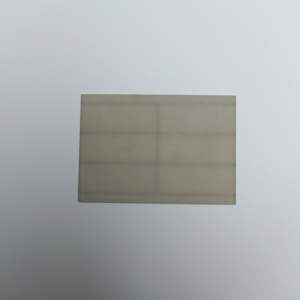
(AlN/aluminum Nitride Ceramic Crucible)
Applications of AlN/aluminum Nitride Ceramic Crucible
Aluminum nitride (AlN) ceramic crucibles are widely used in sectors calling for high thermal stability and chemical resistance. These crucibles deal with extreme temperature levels, typically above 2000 ° C. Their low thermal development lowers splitting risks throughout quick home heating or cooling. This makes them reliable for repeated usage in extreme environments.
In semiconductor production, AlN crucibles thaw and process products like gallium arsenide or silicon. The crucibles avoid contamination due to the fact that aluminum nitride resists reactions with most molten steels. This pureness is critical for creating high-grade electronic components.
Steel handling markets utilize AlN crucibles to melt steels such as aluminum, copper, and alloys. The product’s resistance to corrosion ensures longevity despite hostile metals. Compared to typical graphite or quartz crucibles, AlN lasts longer and minimizes downtime for replacements.
Crystal growth applications depend on AlN crucibles for expanding materials like sapphire. The crucibles keep security under heats and vacuum cleaner problems. This makes certain constant crystal top quality, which is vital for optics and laser technologies.
Research study laboratories utilize these crucibles for high-temperature experiments. They function well with reactive substances or in controlled ambiences. Researchers trust their efficiency in sintering sophisticated porcelains or studying material behaviors under extreme warm.
AlN crucibles are likewise common in LED and laser diode manufacturing. Their capacity to stand up to thermal tension and resist chemical wear supports accurate production processes. This aids maintain efficiency and minimizes problems in final products.
The automotive and aerospace markets take advantage of AlN crucibles when developing heat-resistant components. These crucibles help in developing finishings or alloys that boost engine parts or turbine blades. Their resilience straightens with the industries’ demand for reputable products.
Aluminum nitride ceramic crucibles use a functional option for requiring thermal and chemical obstacles. Their versatility spans multiple fields, from electronics to metallurgy. Customers prioritize them for their performance, cost-effectiveness, and ability to enhance product high quality.
Company Introduction
Advanced Ceramics founded on October 17, 2014, is a high-tech enterprise committed to the research and development, production, processing, sales and technical services of ceramic relative materials and products.. Since its establishment in 2014, the company has been committed to providing customers with the best products and services, and has become a leader in the industry through continuous technological innovation and strict quality management.
Our products includes but not limited to Silicon carbide ceramic products, Boron Carbide Ceramic Products, Boron Nitride Ceramic Products, Silicon Carbide Ceramic Products, Silicon Nitride Ceramic Products, Zirconium Dioxide Ceramic Products, Quartz Products, etc. Please feel free to contact us.(nanotrun@yahoo.com)

Payment Methods
T/T, Western Union, Paypal, Credit Card etc.
Shipment Methods
By air, by sea, by express, as customers request.

5 FAQs of AlN/aluminum Nitride Ceramic Crucible
What is an Aluminum Nitride Ceramic Crucible? Aluminum nitride ceramic crucibles are containers made from aluminum nitride. This material is a synthetic ceramic. It combines aluminum and nitrogen atoms. These crucibles are known for high thermal conductivity. They resist extreme temperatures and chemical corrosion. They are ideal for applications requiring heat management and durability.
What industries use these crucibles? These crucibles are common in semiconductor manufacturing. They are used in metal processing and high-temperature research labs. They handle molten metals, crystal growth, and chemical reactions. Their stability makes them suitable for harsh environments. They are also used in aerospace and electronics for specialized heat treatments.
How hot can these crucibles get? Aluminum nitride crucibles withstand temperatures up to 2200°C in inert atmospheres. In air, their limit is around 1400°C due to oxidation. They handle rapid temperature changes without cracking. This makes them better than many other ceramics for thermal shock resistance.
Are there handling precautions? Avoid dropping or striking the crucible. Aluminum nitride is hard but brittle. Sudden impacts can cause cracks. Use gloves to prevent contamination from oils or moisture. Store them in dry conditions. Exposure to humidity for long periods may affect performance.
How do I clean an Aluminum Nitride Crucible? Clean residues with mild detergents or diluted acids. Avoid abrasive scrubbing. Ultrasonic cleaners work for stubborn particles. Rinse thoroughly with distilled water after cleaning. Do not use alkaline solutions. They can damage the surface. Dry completely before reuse to prevent thermal stress.
Why pick aluminum nitride over alumina or quartz? Aluminum nitride conducts heat better than alumina. It lasts longer in corrosive environments compared to quartz. It resists wear from molten metals. Its thermal properties ensure even heat distribution. This reduces energy waste in high-temperature processes.
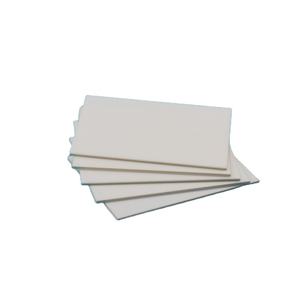
(AlN/aluminum Nitride Ceramic Crucible)
REQUEST A QUOTE
RELATED PRODUCTS
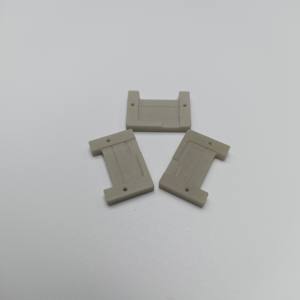
High Quality Thermal Conductive Sheet AlN Aluminum Nitride Ceramic Substrate

High Thermal Conductivity Aluminum Nitride ALN Ceramic Sheet Plate Board
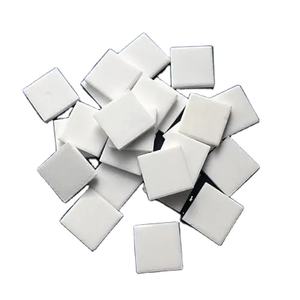
High Purity Aluminum Nitride Ceramic ALN Granule 70-120um 99.95%
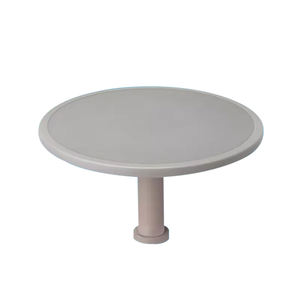
AlN ceramics hot pressed aluminium nitride plate
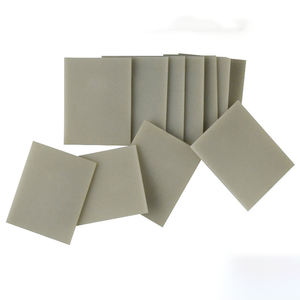
Customized AlN Single Crystal Substrate Aluminium Nitride Plate Ceramic Heater Heating element for Semiconductor Chip Equipment
